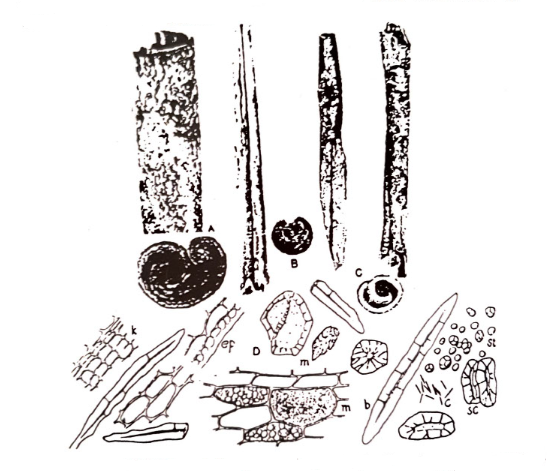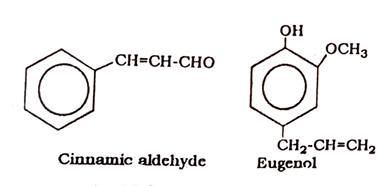Synonyms
Cinnamon Bark, Ceylon Cinnamon, Cinnamomi Cortex
Botanical Source
Cinnamon consists of the dried inner bark of the shoots of coppiced trees of Cinnamomum zeylanicum Nees, Family Lauraceae.
Geographical Source
Cinnamomum zeylanicum· is a small evergreen tree indigenous to Sri Lanka and cultivated in Sri Lanka and South India.

Fig. 50: Cinnamon. A-C, vaneues in longitudinal and transverse view: A, Saigon; B, Ceylon; C, Cassia; D, cellular elements in powdered Cinnamon: b, fibres; c, calcium oxalate crystals; ep, fragment of epidermis and parenchyma; k, fragment of cork; m, parenchymatous cells containing an amorphous brown substances; sc, stone cells; st, starch grains. (Reconstructed from Claus & Tyler).
Cinnamon Macroscopical Characters
Cinnamon bark occurs in single or double, closely packed, compound quilled pieces, up to 1 metre in length, 1 to 2 cm in diameter and about 0.5 mm in thickness, pale brown in colour. The outer surface is marked with pale, wavy. longitudinal lines of pericyclic fibres, and shows occasional scars of the lateral branches. The inner surface has faint longitudinal striations and is somewhat darker in colour than the outer surface. Fracture is brittle and splintery; the fractured Surface show dark brown secondary phloem intercepted by pale medullary rays and surrounded by a ring of buff coloured sclerenchyma. Cork and cortex arc absent. Odour is fragrant aromatic; taste warm, sweet and aromatic.

Microscopical Characters
Cork and primary cortical cells are absent. except for occasional patches. Theoutermost layer consists of a 2 to 3 celled thick ban of pericyclic lignified sclerenchyma (similar to stone cells) associated with occasional groups of pcricyclic fibres. Each intact fibre is strongly thickened with pitted, lignified walls and concentric striations. Phloem parenchyma consists of elongated cell exhibiting numerous circular pits and containing acicular microcrystals of calcium oxalate and starch grains. Isolated or groups of fibres, similar to the pcricyclic fibres in structure, occur along with the phloem parcnchytna. Empty, elongated secretion cells occur in the phloem tissue. Two cells wide medullary rays traverse the phloem.
Powdered Cinnamon
contains numerous thick-walled and pitted phloem in fibres, isolated or in groups, abundant starch grains and acicular microcrystals of calcium oxalate in parenchymatous cells, and a few sclerenchymatous cells.
Chemical Constituents
Cinnamon contains 0.5 to 6.0 percent of volatile oil, the chief constituent of which is cinnamic aldehyde (60-70%) and eugenol (4%). Cinnamon also contains tannin and mucilage

Uses of Cinnamon
Cinnamon is chiefly used as a carminative and flavouring agent. It also possesses astringent and antibiotic properties. It is commercially used for extraction of Cinnamon oil and also as a spice.
Substitutes and Adulterants
The dried barks of other species Cinnamon, particularly Cinnamon cassia and C. Laure are used as substitutes and barks of other related plants adulterants of Cinnamon.

